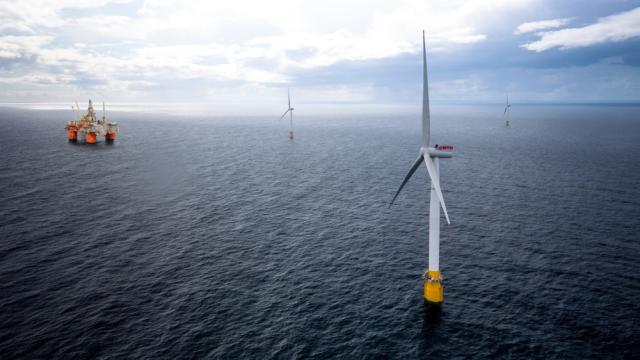
Equinor is assessing the feasibility of using floating wind turbines to provide power to its Snorre and Gullfaks facilities. (Source: Equinor)
While demand for oil will peak in 2023, demand for gas will continue increasing through 2034 as the world becomes increasingly electrified, DNV GL said in a forecast of world energy supply and demand out to 2050.
As a result, global gas capital spending will grow from $960 billion in 2015 to a peak of $1.3 trillion in 2025, while operational spending will rise by 30% between 2015 and 2040, according to DNV GL’s 2018 Energy Transition Outlook.
Other trends the outlook predicts include North America continuing to dominate unconventional gas production and seaborne gas trade from North America to China trebling by 2050.
Conventional onshore and offshore gas production is expected to decline from about 2030, while unconventional onshore gas is expected to rise to a peak in 2040, according to the outlook, leading to a growth in leaner and shorter life-span gas developments.
“It’s important for the oil and gas industry to work on efficiency and also competitiveness and for gas to take over from oil it has to be cheaper,” said Liz Hovem, CEO of DNV GL-Oil & Gas. “To be cheaper, it has to be produced in a cost-effective way.”
But as focus grows on cleaner fuels, including biogases, the industry will not only have to work toward being cleaner and leaner, there will also be other changes, including the introduction of greener gases, such as biogas, syngas and hydrogen, into transmission and distribution systems, she says.
Work is starting in this space. Hovem cites a joint industry project which is assessing how equipment and infrastructure that is in place can cope with throughput of hydrogen, instead of natural gas. In Leeds, in the U.K., there’s a project, called H21, which is looking to convert natural gas infrastructure that takes gas to people’s homes for heating to a hydrogen system. There’s potential for that hydrogen to be produced from natural gas offshore and for it to be piped to shore for use as a fuel, Hovem said, stripping the carbon off it before it goes into the energy system.
Norwegian energy firm Equinor revealed it is doing research in this area at the European Gas Conference in Oslo earlier this year, she said. Engineering firm Jacobs has started a gas-to-hydrogen including carbon capture feasibility study for Equinor.
While hydrogen is a small part of the energy mix now, it could play a much larger role and faster than might be expected, just like wind and solar energy development grew faster than expected, she said.
The wider industry is also looking to other ways to “greenify” itself, including using offshore floating wind turbines to provide power for offshore oil and gas production facilities. Equinor announced during the ONS conference and exhibition in Stavanger late August that it was assessing the feasibility of using 11 floating wind turbines to provide power to its Gullfaks and Snorre facilities. Earlier this year, Aker BP said its North of Alvheim and Askja-Krafla development will be “energy positive” and with “zero emissions,” by having all-electric topside and subsea infrastructure, powered from shore as well as offshore wind turbines.
Even traditionally oil and gas focused conferences are getting the message—this year’s ONS and Houston’s Offshore Technology Conference had sessions on offshore wind. “It’s a lot about hedging and being prepared and social acceptance,” Hovem said.
Back to natural gas, Northeast Eurasia (including Russia) and the Middle East and North Africa, will account for most onshore conventional gas production in the lead up to 2050, while North America will continue to dominate unconventional gas production, the report said. In the offshore sector, the Middle East and North Africa will see the highest annual rate of new gas production capacity from now until at least 2050.
LNG capacity will increase as production rises, doubling by the late 2040s, according to DNV GL, as gas is shifted to demand centers. Seaborne gas trade is expected to treble from North America to China by 2050 and an increase in trade from Sub-Saharan Arica to India and South East Asia is also expected.
Recommended Reading
Hess Midstream Increases Class A Distribution
2024-04-24 - Hess Midstream has increased its quarterly distribution per Class A share by approximately 45% since the first quarter of 2021.
Baker Hughes Awarded Saudi Pipeline Technology Contract
2024-04-23 - Baker Hughes will supply centrifugal compressors for Saudi Arabia’s new pipeline system, which aims to increase gas distribution across the kingdom and reduce carbon emissions
PrairieSky Adds $6.4MM in Mannville Royalty Interests, Reduces Debt
2024-04-23 - PrairieSky Royalty said the acquisition was funded with excess earnings from the CA$83 million (US$60.75 million) generated from operations.
Equitrans Midstream Announces Quarterly Dividends
2024-04-23 - Equitrans' dividends will be paid on May 15 to all applicable ETRN shareholders of record at the close of business on May 7.
SLB’s ChampionX Acquisition Key to Production Recovery Market
2024-04-21 - During a quarterly earnings call, SLB CEO Olivier Le Peuch highlighted the production recovery market as a key part of the company’s growth strategy.






